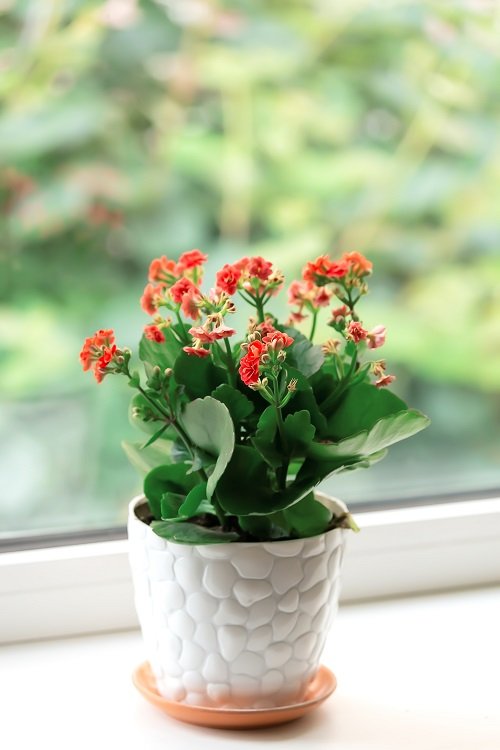The flowering Kalanchoe Plants (Kalanchoe blossfeldianum ) is a fascinating addition to an indoor space with colorful bloom lasting for 2 months. Our comprehensive guide covers all aspects of kalanchoe care for these hardy houseplants that will keep growing and blooming year after year.
Varieties of Kalanchoe

There are many different types of Kalanchoe plants, each with its unique features. Here are a few varieties you might like:
Aurora Borealis: A variegated type with serrated, green-white, and pink-rimmed leaves.
Beach Bells: Known for its long-curved stems, green leaves, and clusters of red bell-shaped flowers.
Calandiva: A bushy succulent with clusters of ornamentals, and double flowers that resemble rose blooms.
Wendy: Has ovate succulent foliage and bell-shaped, purple-pink blooms tipped with pale yellow.
These are just a few examples, but there are many more Kalanchoe varieties to explore and enjoy in your garden or as houseplants. Read more about details of Kalanchoe plants.
Kalanchoe blossfeldiana: A Brief Overview
The Kalanchoe blossfeldiana plant was found in Madagascar by a scientist named Robert Blossfeld. It does well inside homes, growing to about eight inches tall and wide. It has many names like flaming Katy and Christmas Kalanchoe, which show how much people like it and how well it can grow in different places.
How To Grow Kalanchoe Plants
Kalanchoe blossfeldianum, also known as flaming Katy, is a succulent plant that can be easily propagated by stem or leaf cuttings. Here are the basic steps for propagating kalanchoe blossfeldianum.
1. Use a sharp and clean tool to cut a few 6–8 inch green shoots from a healthy kalanchoe plant. Remove it leaves from the bottom 3 inches of the cuttings.
2. Let the cuttings dry for three days in a shaded place. This will allow the wounds to heal and prevent rotting.
3. Fill a pot with damp succulent and cactus soil mix and make small holes for the cuttings. You can optionally dip the cut ends of the cuttings in rooting hormone powder to speed up the rooting process.
4. Plant the cuttings in the soil and press firmly to hold them in place. Water lightly and place the pot in a bright location with indirect light.
5. Keep the soil slightly moist but not soggy until the cuttings root, which usually takes 15 to 20 days. You can check the rooting progress by gently tugging on the cuttings. If they resist, they have rooted.
Once the cuttings have rooted, you can transplant them to larger pots or garden beds and care for them as normal kalanchoe plants.
Remember, Kalanchoe plants are not safe for cats and dogs. Keep your plants where pets can’t reach them. With proper care, your Kalanchoe will grow well and add beautiful colors to your space!
The Importance of Light

Kalanchoe plants need good light to grow well. It’s best to put them near a window that faces west or south when it’s winter. They come in many colors and shapes, so they fit with any room style. People like to display them with other holiday plants like poinsettias and cyclamen.
Watering Strategies
Kalanchoe plants are succulents, so it’s okay if you sometimes forget to water them. Just make sure the soil gets dry before you water again. Water them only when the top 1 or 2 inches of soil are dry, Don’t let the leaves stay wet because they might get spots or rot. Use soil that drains well and a pot that lets water out to stop the roots from rotting.
Check out Beauty of Succulents with Pink Flowers: A Gardener’s Guide
Fertilization for Optimal Growth
To keep your kalanchoe healthy, give it plant food in the spring. Don’t feed it when it’s blooming. Using a natural liquid plant food as part of your normal care for houseplants will help it grow strong.
Prolonging Blooms and Encouraging Reblooming

To make your kalanchoe bloom longer and get new flowers, cut off the dead flowers with sharp, clean scissors. For more blooms, give the plant less light to make it feel like the days are getting shorter. Cut back on water and light slowly for a month, then take care of it like usual when you see new buds.
Guarding Against Pests
Watch out for bugs like scale, mealybugs, aphids, and spider mites that can harm your kalanchoe. It’s important to be careful and follow steps to keep these pests away, as explained in our guide on bugs in houseplants, to make sure your plant stays healthy and free of pests.
Repotting Guidelines
If your kalanchoe gets too big for its pot, repot it after it’s done blooming. Pick a bigger pot with holes at the bottom and use special soil for succulents that drains well. This helps avoid too much water staying in the soil, which can cause the roots to rot.
Check out How to Care for Cotyledon Pendens Succulents
Learning how to take care of kalanchoe plants will help them grow well and bring beautiful flowers to your home. Use our complete guide to make sure your kalanchoe stays healthy and becomes a lovely part of your indoor garden.
Pingback: 10 Japanese Indoor Plants: Enhancing Your Home with Greenery
Pingback: 10 Easy Indoor Blooming Plants for Winter Color -
Pingback: 20 Low Light Succulents For Indoor Spaces -
Pingback: Blooming Beauties: 20 Flowers That Start with E -
Pingback: Guide to Growing the Beautiful Crown of Thorns Plant -
Pingback: Stunning Succulent Gardens: A Beginner’s Guide -
Pingback: 15 Popular Types of Succulents for Your Garden -
Pingback: Planting Succulents: 8 Tips for a Vibrant Succulent Garden
Pingback: Easy Guide to Growing Charming Hens and Chicks Succulents